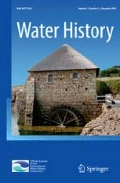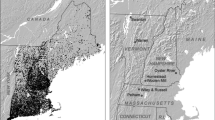Abstract
The Edwards Dam, located on the Kennebec River of Maine, in the state’s capitol city, was removed in 1999 to restore fisheries such as alewives, striped bass, American shad, and endangered short-nosed sturgeon. The dam removal was ordered by the Federal Energy Regulatory Commission for the express purpose of restoring fisheries, the first time ever this was done in American history. This article examines the local environmental advocacy for river and fisheries restoration and the process resulting in dam removal and fisheries restoration. It argues that the Edwards Dam removal was critical in proving the environmental benefits of river restoration through removal as well as some economic benefits. This contributed to other U.S. efforts to remove dams to restore fisheries and assisted the expansion of this stage of American environmentalism. The article uses a number of primary sources including local newspapers, environmental group materials, and a number of interviews collected by the author.
Similar content being viewed by others
Notes
Stephen Brooke Interview.
Carpenter (1989)
Greg Ponte Interview.
This topic has not been studied intensively. Lowery (2003) discusses it in his political science study. His coverage of the effort to restore the Kennebec River through removal of the Edwards Dam is a good, concise study that works well with his comprehensive examination of dam removal efforts nationwide. Grossman (2002) also writes about the Edwards Dam fight in Watershed: The Undamming of America. This book is also a wide-ranging examination of efforts to remove dams and restore fisheries nationwide. It is designed for a more general, non-academic audience and is very good. Both books are quite good. This article goes into a great deal more depth with a wider range and depth of sources than either Lowery or Grossman do in telling this story. Furthermore, this piece captures more of the complexity of the restoration efforts and the negotiations to get the dam finally removed while keeping multiple stakeholders as happy as was possible given the tensions of a 10 year fight.
Manlove (1990b); The congress passed and President George H.W. Bush signed the Elwha Restoration Act in 1992. This legislation, which had consensus support from Washington’s Republican and Democratic legislators, called for removal of two dams on the Elwha River of the Olympic Peninsula to restore the river’s once magnificent salmon runs. The activists supporting restoration of the Elwha River had crafted a remarkable body of consensus behind this legislation—the dam owners, the owners of the lumber mill using power from the dams, the Port Angeles Chamber of Commerce, multiple state and federal agencies, and the Elwha Klallam Indians had all supported this legislation. This was democracy at its finest. However, the appropriations for dam removal were blocked by Republican Senator Slade Gorton of Washington as he changed his position on Elwha restoration as concerns over dam removal efforts grew and conservatives and businessmen mounted their resistance to proposals on other rivers such as the Lower Snake River in Washington. As of the publishing of this article in 2009, the Elwha Dams still stand and are slated to be removed in 2012.
Brooke Interview.
O’Donnell et al. (2000).
Kennebec River Annual Progress Report, 2000 and Squiers interview.
North (1870).
Stanley (1988).
Brooke Interview.
Leighton (1989).
Brooke Interview.
Ibid; Lowery (2003, p. 78).
See footnote 14.
Brooke Interview; “Dam Management Defended,” Kennebec Journal, 7–8 October 1989.
Harden (1997).
Brack (1990b).
Manlove (1990b).
Hood (1990).
“Maine Asks U.S. to Deny License to Dam Owners,” New York Times, 17 October 1990, A21.
Brooke Interview.
Ibid.
Cheever (1997a).
Porter (1994).
Evan Richert Interview.
Opponents of the proposed dam in 1834 argued that the dam would do great damage both ecologically and economically to many users of the river and its fisheries. They believed and were correct in doing so, that the dam would destroy the fisheries of the Kennebec River, and this would enable them ramify into further ecosystems such as the ocean fisheries dependent on shad, herring, alewives, etc. Crane (2009).
Richert Interview.
Richert Interview.
Goldberg (1997).
Howe (1997).
Ibid.
See footnote 3.
Cheever (1997b).
Ibid.
Ibid.
“Dam Ruling Blow to Industry,” London Financial Times, 27 November 1997, 3.
Jovin (1998).
Bangor Daily News, 31 December 1997.
Cheever (1998a).
Ibid.
Cheever (1998b).
Richert Interview.
Cheever (1997b).
Dave Cheever Interview.
Brooke Interview; Richert Interview; McPhee (2002).
McPhee, The Founding Fish, 73, 74.
Adams (1999).
Ibid.
Richert Interview.
McPhee, The Founding Fish, 79.
Lee (1999).
Ibid.
Paulson (1999).
Ibid.
Ibid.
“River is Alive in Ways Not Seen for Almost 200 Years,” Kennebec Journal Morning Sentinel 28 June 2009.
Cronon (1995) discusses declensionist narratives in his essay, “The Trouble with Wilderness; or, Getting Back to the Wrong Nature”. Within the field of environmental history, the debate over declensionist narratives is a hotly contested one. At the First World Congress of Environmental History in Copenhagen in August, 2009, there were multiple references in plenary sessions and paper presentations to the need to avoid declensionist narratives and provide more positive and complex narratives of the intersection of nature and culture. The story of the Kennebec restoration is a positive story in a world of mostly negative environmental stories.
Maine Department of Marine Resources, Annual Report 2001, January 2002, 22; “Stripers Caught Above Edwards Dam,” Fly Fisherman, 31:2 (Feb. 2000): 26; McGillvray (2000).
Grard (2009).
References
Adams G (1999) Maine demolition is first done against owner’s wishes. Seattle Times.com, 1 July
Brack K (1990a) State explains its dam plan: local legislators unhappy over eminent domain proposal. Kennebec Journal, 16 March, 1, 12
Brack K (1990b) Augusta takes on big brother for dam. Kennebec Journal, 19 March, 1, 8
Brack K (1990c) Dam issue gets closer look. Kennebec J, 23 March, 1, 12
Carpenter B (1989) Conservationists are challenging the utility of old dams. U.S. News and World Report, 16 October, 90
Cheever D (1997a) City dissatisfied; plans appeal after a review. Kennebec Journal, 26 November, 1
Cheever D (1997b) Coalition crows at federal decision. Kennebec Journal, 26 November, 1
Cheever D (1998a) More join in Edwards appeal. Kennebec Journal, 5 January, 1
Cheever D (1998b) Senators protest lack of reprieve for Edwards owners. Kennebec Journal, 9 February, 1
Cheever D (1998c) Augusta approves pact on old dam: the city agrees to let the state take possession and dismantle the Edwards dam. Portland Press Herald, 5 May
Cheever D (1998d) Edwards removal OK’d: city signs agreement with state, manufacturing company. Kennebec Journal, 9 May, 1
Chutchian KZ (1990) Kennebec fish stage A comeback: but dioxin still poses a problem. Kennebec Journal, 22 March
Crane J (2009) Fancy foreshadowed a magnificent destiny: the market revolution and the Kennebec dam fight. In: Egan M, Crane J (eds) Natural protest: essays on the history of American environmentalism. New York, Routledge Press
Cronon W (1995) The trouble with wilderness; or, getting back to the wrong nature. In: Cronon W (ed) Uncommon ground: rethinking the human place in nature. New York, W. W. Norton & Co, pp 69–90
Goldberg C (1997) Fish are victorious over dams as U.S. agency orders shutdown. New York Times, 26 November, A16
Grard L (2009) Alewives made huge splash: this year’s run could be largest in the U.S. Kennebec Journal Morning Sentinel, 2 July
Grossman E (2002) Watershed: the undamming of America. Counterpoint, New York
Harden B (1990) With industry, sewage plans, citizens play role. Kennebec Journal, 22 March
Harden B (1997) U.S. orders dam destroyed; for first time, fish habitat takes priority over a hydroelectric dam. Washington Post, 26 November, A1
Hood L (1990) D.C. group explains support of plan to breach Edwards dam. Kennebec Journal, 22 March
Howe PJ (1997) US ends Maine dam’s license as environment gets the nod. Boston Globe, 26 November, A1
Jovin E (1998) Edwards dam: a watershed decision for hydropower. Electrical World, 212:3 (March), 44
Lee P (1999) Maine river set free in ‘Act of Restoration’. Ottawa Citizen, 2 July, A7
Leighton K (1989) Coalition ready to apply for control of Edwards Dam. Kennebec Journal, 3 March
Lowery WR (2003) Dam politics: restoring America’s rivers. Georgetown University Press, Washington, DC, p 78
Manlove G (1990a) Our river vastly improving, but cleanup battle isn’t over. Kennebec Journal, 20 March, 1
Manlove G (1990b) Removal of dam would alter face of river. Kennebec J, 22 March, 8, 9
McGillvray D (2000) River’s rebirth surprises even most ardent supporters. Kennebec Journal, 30 June, A1
McPhee J (2002) The founding fish. Farrar, Straus and Giroux, New York, p 77
North JW (1870) The history of Augusta: from the earliest settlement to the present time. Clapp and North, Augusta, ME, pp 571–572
O’Donnell M, Gray N, Wippelhauser G, Christman P (2000) Kennebec River diadromous fish restoration: Annual Progress Report—2000. Maine Department of Marine Resources, Augusta, Maine, p 8
Paulson M (1999) Potomac watch: Babbitt shows abrasive outlook—by a dam site. Seattle Post-Intelligencer, 5 July. Seattle P-I.com
Porter N (1994) Shortnose sturgeon at center of debate on damming rivers. Bangor Daily News, 15 September
Stanley T (1988) Fish passage to be installed at Augusta dam. Kennebec Journal, 5 May
Author information
Authors and Affiliations
Corresponding author
Rights and permissions
About this article
Cite this article
Crane, J. “Setting the river free”: The removal of the Edwards dam and the restoration of the Kennebec River. Water Hist 1, 131–148 (2009). https://doi.org/10.1007/s12685-009-0007-2
Received:
Accepted:
Published:
Issue Date:
DOI: https://doi.org/10.1007/s12685-009-0007-2




